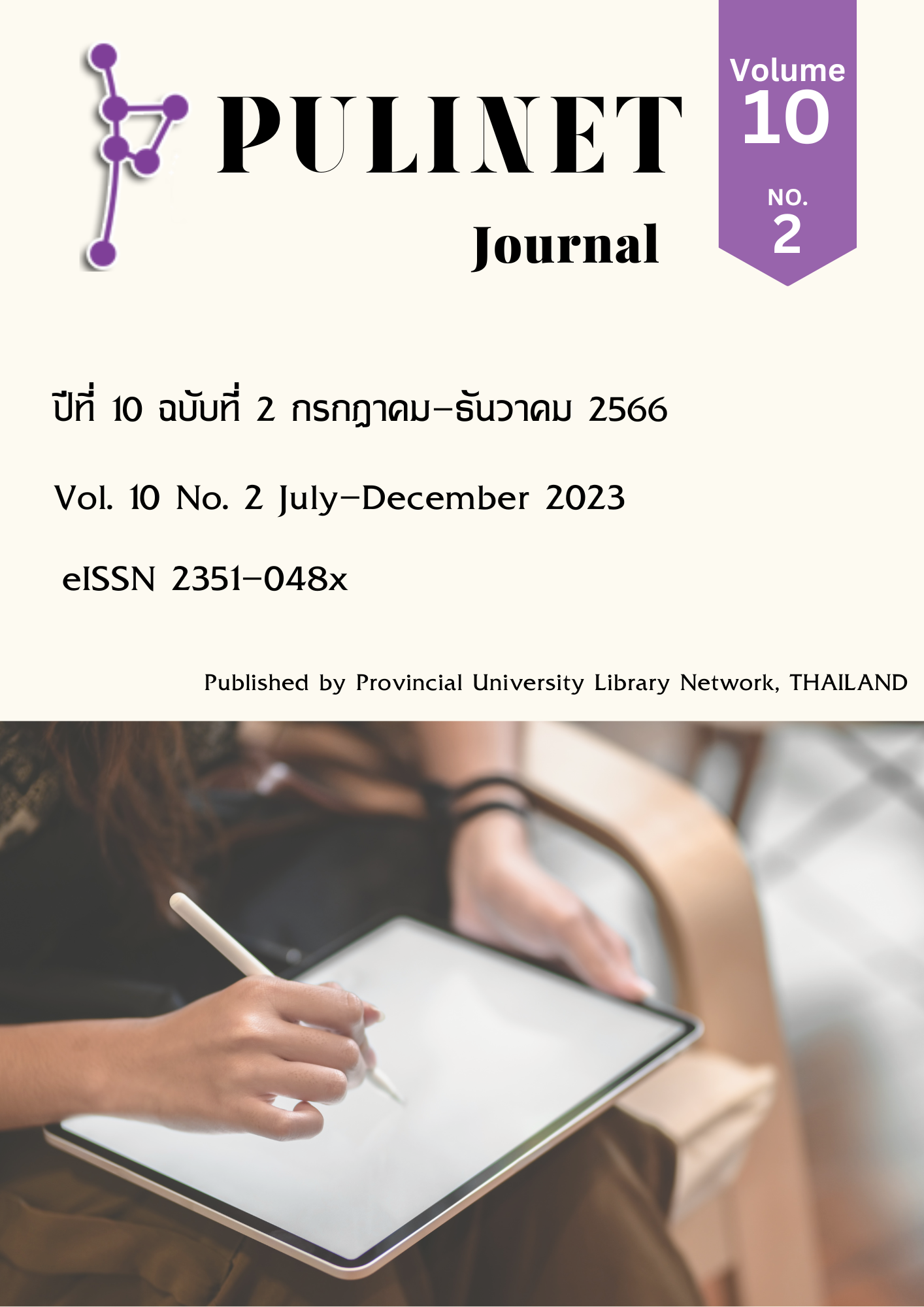การประเมินคุณภาพของทรัพยากรสารสนเทศอิเล็กทรอนิกส์ด้วยตัวชี้วัดเชิงคุณภาพ
Main Article Content
บทคัดย่อ
การวิจัยนี้มีวัตถุประสงค์เพื่อประเมินคุณภาพของทรัพยากรสารสนเทศอิเล็กทรอนิกส์ด้วยตัวชี้วัดคุณภาพทรัพยากรสารสนเทศอิเล็กทรอนิกส์ เพื่อทราบแนวทางในการพัฒนาทรัพยากรสารสนเทศทุกประเภทในการสนับสนุนการเรียนการสอน การวิจัย และความคุ้มค่าคุ้มทุน และเพื่อนำผลการวิจัยไปใช้ประกอบการบริหารงบประมาณในการบอกรับทรัพยากรสารสนเทศอิเล็กทรอนิกส์ โดยวิเคราะห์คุณภาพของทรัพยากรอิเล็กทรอนิกส์ของห้องสมุดจากวารสารอิเล็กทรอนิกส์ 3,080 ชื่อ หนังสืออิเล็กทรอนิกส์ 4,400 ชื่อ และฐานข้อมูลอิเล็กทรอนิกส์ จำนวน 20 ฐานข้อมูล
ผลการวิจัยพบว่าจากวารสารอิเล็กทรอนิกส์ทั้งหมดที่ห้องสมุดบอกรับ จำนวน 3,080 ชื่อ เมื่อประเมินคุณภาพวารสารอิเล็กทรอนิกส์ด้วยตัวชี้วัดคุณภาพทรัพยากรสารสนเทศอิเล็กทรอนิกส์ 8 ตัวชี้วัด ได้แก่ จำนวนครั้งของวารสารที่ถูกอ้างอิงในผลงานตีพิมพ์ การถูกเสนอชื่อจากภาควิชา สถิติการเข้าใช้วารสาร ค่าใช้จ่ายต่อการเข้าใช้วารสาร Journal Impact Factor, Journal Quartile Score, Journal Percentile Score และ ค่า Altmetric พบว่ามีวารสารทั้งหมดจำนวน 2,665 ชื่อ ที่มีค่าตัวชี้วัดตามเงื่อนไข คิดเป็นร้อยละ 86.52 ด้านคุณภาพของหนังสืออิเล็กทรอนิกส์ เมื่อประเมินคุณภาพหนังสืออิเล็กทรอนิกส์ด้วยตัวชี้วัดคุณภาพทรัพยากรสารสนเทศอิเล็กทรอนิกส์ 4 ตัวชี้วัด ได้แก่ รายชื่อหนังสือที่ปรากฏรายชื่อใน มคอ.3 หมวด 5 หนังสือที่ภาควิชาเสนอชื้อ สถิติการเข้าใช้หนังสือ และค่าใช้จ่ายต่อการเข้าใช้หนังสือ พบว่า มีหนังสืออิเล็กทรอนิกส์ จำนวน 2,887 ชื่อ ที่มีค่าตัวชี้วัดตามเงื่อนไข คิดเป็นร้อยละ 72.17 ด้านคุณภาพของฐานข้อมูลอิเล็กทรอนิกส์พบว่า จากฐานข้อมูลทั้งหมดจำนวน 20 ฐานข้อมูล มีค่ามัธยฐานการใช้ฐานข้อมูลอยูที่ 29,921 ครั้ง และค่าใช้จ่ายเฉลี่ยต่อครั้งในการเข้าใช้ฐานข้อมูลทุกประเภทเท่ากับ 65.75 บาท
Article Details

อนุญาตภายใต้เงื่อนไข Creative Commons Attribution-NonCommercial-NoDerivatives 4.0 International License.
เอกสารอ้างอิง
จอย ผิวสะอาด และแววตา เตชาทวีวรรณ. (2563). การประเมินทรัพยากรสารสนเทศของสำนักหอสมุดและศูนย์สารสนเทศวิทยาศาสตร์และเทคโนโลยีด้วยวิธีการวิเคราะห์การอ้างอิงในผลงานทางวิชาการของบุคลากรสังกัดกรมวิทยาศาสตร์บริการ. วารสารบรรณศาสตร์ มศว., 13(1), 52-65. https://so02.tcithaijo.org/index.php/JLIS_SWU/article/view/243127/165122
ชมพูนุช สราวุเดชา. (2563). การวิเคราะห์ความสอดคล้องของการจัดหาและความต้องการใช้วารสารของอาจารย์คณะแพทยศาสตร์ มหาวิทยาลัยเชียงใหม่. Pulinet Journal, 7(2), 38-50. https://pulinet.oas.psu.ac.th/index.php/journal/article/view/415/401
ดวงใจ กาญจนศิลป์ และวิไลลักษณ์ อินมีศรี. (2556). ความคุ้มค่าของทรัพยากรสารสนเทศของศูนย์บรรณสารและสื่อการศึกษามหาวิทยาลัยเทคโนโลยีสุรนารี. มหาวิทยาลัยเทคโนโลยีสุรนารี.
เพียงขอบฟ้า ปัญญาเพ็ชร. (2557). การวิเคราะห์การอ้างถึงในบทความวิจัยของอาจารย์คณะแพทยศาสตร์ มหาวิทยาลัยเชียงใหม่ [วิทยานิพนธ์ปริญญามหาบัณฑิต ไม่ได้ตีพิมพ์]. มหาวิทยาลัยเชียงใหม่.
เพียงขอบฟ้า ปัญญาเพ็ชร. (2562). การวิเคราะห์ความสอดคล้องของทร้พยากรสารสนเทศอิเล็กทรอนิกส์ต่อหลักสูตรการศึกษาระดับบัณฑิตศึกษา คณะแพทยศาสตร์ มหาวิทยาลัยเชียงใหม่. สำนักหอสมุดมหาวิทยาลัยเชียงใหม่.
มหาวิทยาลัยเชียงใหม่. (2562). ปณิธาน/วิสัยทัศน์/พันธกิจ/ค่านิยมและวัฒนธรรมองค์กร. มหาวิทยาลัยเชียงใหม่. https://www.cmu.ac.th/th/cmu/resolution
มหาวิทยาลัยเชียงใหม่. (2559). (ร่าง) แผนพัฒนาการศึกษามหาวิทยาลัยเชียงใหม่ ระยะที่12 (พ.ศ. 2560 - 2564). มหาวิทยาลัยมหาวิทยาลัยเชียงใหม่.
ยุพา ดวงพิมพ์, ลออ ข้อยุ่น, มุกดา ดวงพิมพ์, และ ทรรศนีย์ อินทร์ล้า. (2562). การวิเคราะห์ความสอดคล้องของทรัพยากรการเรียนการสอนในรายวิชาที่เปิดสอนหลักสูตรวิทยาศาสตร์มหาบัณฑิตสาขาวิชาชีววิทยา คณะวิทยาศาสตร์ มหาวิทยาลัยขอนแก่นกับทรัพยากรที่ห้องสมุดมีให้บริการ. Information, 26(1), 91-101. http://infojournal.kku.ac.th/index.php/information/article/view/15
ศิริงาม แผลงชีพ. (2561). การพัฒนาทรัพยากรสารสนเทศ (พิมพ์ครั้งที่ 2). มหาวิทยาลัยรามคำแหง.
สำนักหอสมุด (2565). วิสัยทัศน์ พันธกิจ วัตถุประสงค์เชิงกลยุทธ์. สำนักหอสมุด มหาวิทยาลัยเชียงใหม่. https://library.cmu.ac.th/HtmlDetail/Detail/225/main
ห้องสมุดคณะแพทยศาสตร์ มหาวิทยาลัยเชียงใหม่. (2562). Vision / Mission. ห้องสมุดคณะแพทยศาสตร์ มหาวิทยาลัยเชียงใหม่ https://w1.med.cmu.ac.th/library/about/vision.php
อุทุมพร มณีวรรณ. (2560). การวิเคราะห์การอ้างอิงในวิทยานิพนธ์คณะวิทยาศาสตร์มหาวิทยาลัยเชียงใหม่ [วิทยานิพนธ์ปริญญามหาบัณฑิต ไม่ได้ตีพิมพ์]. มหาวิทยาลัยเชียงใหม่.
Agee, J. (2005). Collection evaluation: a foundation for collection development. Collection building, 24(3), 92-95. https://doi.org/10.1108/01604950510608267
Ahmad, P., Brogan, M., & Johnstone, M. N. (2014). The e-book power user in academic and research libraries: Deep log analysis and user customization. Australian Academic & Research Libraries, 45(1), 35-47. https://doi.org/10.1080/00048623.2014.885374
Ashcroft, L. (2011). Ebooks in libraries: an overview of the current situation. Library Management, 32(6/7), 398-407. https://doi.org/10.1108/01435121111158547
Crawley-Low, J. V. (2002). Collection analysis techniques used to evaluate a graduate-level toxicology collection. Journal-medical Library Association, 90, 310-316.
Cory Tucker, J. (2012). Ebook collection analysis: subject and publisher trends. Collection Building, 31(2), 40-47. https://doi.org/10.1108/01604951211229836
Goertzen, M., & Bakkalbasi, N. (2016). Exploring academic e-book use: part II through focus groups and interviews. Performance Measurement and Metrics, 17(1), 83-92. https://doi.org/10.1108/PMM-09-2015-0025
Hyödynmaa, M., Ahlholm-Kannisto, A., & Nurminen, H. (2010). How to evaluate library collections: a case study of collection mapping. Collection Building, 29(2), 43-49. https://doi.org/10.1108/01604951011040125
Khan, G., & Bhatti, R. (2016). An analysis of collection development in the university libraries of Pakistan. Collection Building, 35(1), 22-34. https://doi.org/10.1108/CB-07-2015-0012
Min, S. L. L., & Casselden, B. (2021). A case study of Singapore Management University Libraries: Adopting a mixed methods approach towards collection evaluation. The Journal of Academic Librarianship, 47(3), 102330. https://doi.org/10.1016/j.acalib.2021.102330
Nikolaidou, M., Anagnostopoulos, D., & Hatzopoulos, M. (2005). Development of a Medical digital library managing multiple collections. The Electronic Library, 23(2), 221-236.
Nisonger, T. E. (1998). Management of Serials in Libraries. Libraries Unlimited.
Proctor, J. (2013). Avoiding ebook “big deals”: alternatives to ebook backlists. New library world, 114(7/8), 301-307. https://doi.org/10.1108/NLW-02-2013-0018
Wolven, R. (2013). Curriculum development resources for teachers and school librarians: A selection of resources. Reference Reviews, 27(6), 4-9. https://doi.org/10.1108/RR-01-2013-0003


